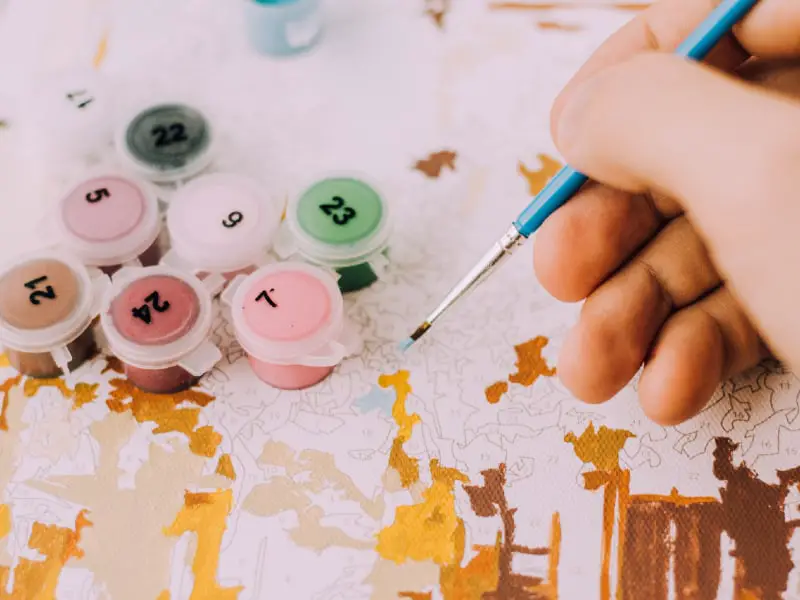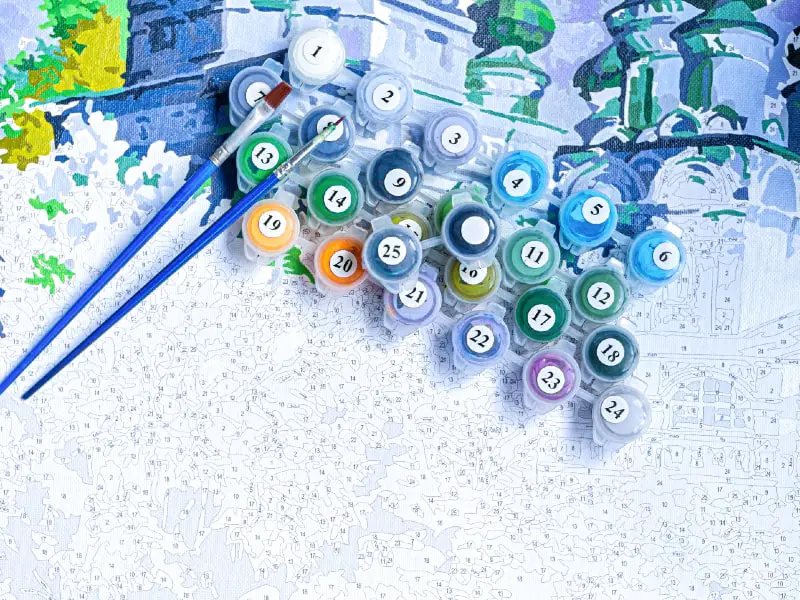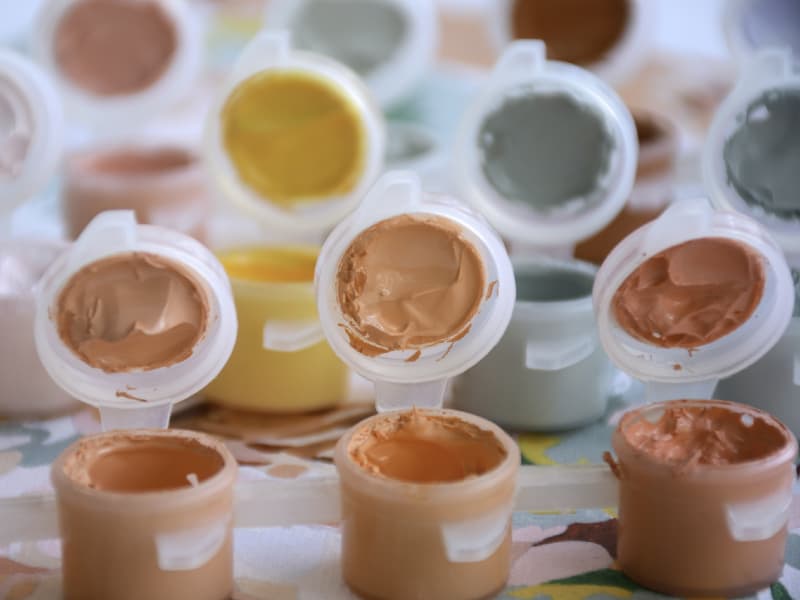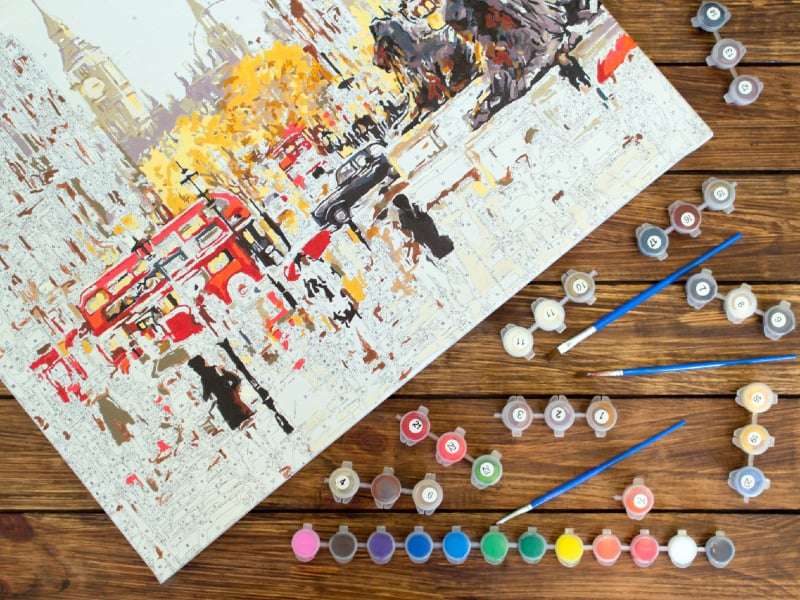If you’re like me and walk into a modern art gallery and laugh or even become slightly enraged by seeing artwork ““ valued at millions of dollars ““ that is little more than a swoosh of paint on a canvas, then you’re probably a fan of populism without realizing it! If not, you might be an elitist. There’s nothing wrong with being on either side of this coin, as it takes all manner of folks to make the world turn. In this article, we’re going to be taking a closer look at the differences between elitism and populism and how this impacts our love for Paint by Numbers.
What is Elitism?
 Elitism is the belief that a sector of society, be this a group of people, the arts, literature, etc., possess intrinsic qualities such as skills, wealth, intellect, or experience that are more valuable to society, and therefore should be deemed as more important than those people or items without these preferred qualities.The modern art community is rife with notions of elitism. This is because art is highly subjective. Either you like a piece, or you don’t. However, elitists will place specific artworks on a pedestal because they ‘understand’ them and see the intrinsic qualities they’re looking for within them.The art piece can then be used as a measure of a person’s worthiness, if they understand and appreciate the piece they are likely allowed into the high-brow elitist club, and can be seen by society as being hyper-educated or cultured. Whereas, if you, like I, view the same piece and scoff at its pointlessness, or lack of skill, we would not be accepted into the elitist club.Common examples of artists who could be considered ‘elitist’ include; Marcel Duchamp (more on him later), Damien Hirst, with his infamous piece ‘Mother and Child (Divided), which featured dissected calves suspended in formaldehyde, and ‘Blue Fool’ by Christopher Wool, which is quite literally, the word fool stenciled on a canvas. Blue Fool sold for a whopping 2.3 million dollars!
Elitism is the belief that a sector of society, be this a group of people, the arts, literature, etc., possess intrinsic qualities such as skills, wealth, intellect, or experience that are more valuable to society, and therefore should be deemed as more important than those people or items without these preferred qualities.The modern art community is rife with notions of elitism. This is because art is highly subjective. Either you like a piece, or you don’t. However, elitists will place specific artworks on a pedestal because they ‘understand’ them and see the intrinsic qualities they’re looking for within them.The art piece can then be used as a measure of a person’s worthiness, if they understand and appreciate the piece they are likely allowed into the high-brow elitist club, and can be seen by society as being hyper-educated or cultured. Whereas, if you, like I, view the same piece and scoff at its pointlessness, or lack of skill, we would not be accepted into the elitist club.Common examples of artists who could be considered ‘elitist’ include; Marcel Duchamp (more on him later), Damien Hirst, with his infamous piece ‘Mother and Child (Divided), which featured dissected calves suspended in formaldehyde, and ‘Blue Fool’ by Christopher Wool, which is quite literally, the word fool stenciled on a canvas. Blue Fool sold for a whopping 2.3 million dollars!
What is Populism?
Populism is the complete opposite of elitism. Populism is all about the will and opinions of the masses, instead of the few which elitism concerns itself with. The term was first coined in the 1800s and has been adopted as a political stance as well as helping to fuel a variety of movements such as the ‘Occupy Wall Street’ movement.Landscape artist Thomas Kinkade perfectly encapsulates the power of populism. His saccharine fantasy land paintings drew great critical disdain, which left Kinkade largely shunned by the wider fine art community despite Kinkade having impressive technical skill and exemplary use of light and shade. Put simply, he gave people what they wanted instead of what he thought they should want.Despite this derision from the elitist art critics, Kinkade was a massive commercial and populist success. In fact, it’s estimated that one in every 20 homes in the USA have some form of Kinkade artwork in their homes, making Kinkade one of the most successful artists the USA has ever seen! Kinkade’s work is also one of the most commonly used in Paint by Number kits, an activity which would be sure to have the fine art world rolling their eyes at – which I think he’d be pleased about were he alive today! His work brings joy to those who encounter it, be that through Disney, art museums, or Paint by Number kits.
Paint by Numbers
 So, you may be wondering what precisely the joy of Paint by Numbers has to do with terms like ‘elitism’ and ‘populism.’ Well, first of all, Paint by Numbers can definitely be declared a populist art form that is shunned by elitists as little more than a ‘hobby for the elderly.’ And yet, many elitist art critics practice double standards, as when an artist creates a paint by numbers mural, such as the mural created by Lance Whitner, or something along a similar theme, critics applaud the work for being innovative and collaborative.This shaming attitude practiced by the art world, and now wider society needs to come to an end. So many people are put off from ever undertaking a creative outlet because they are worried about not being ‘good at art’ or being judged for their passion, meaning that many stop before they ever begin. From small acorns grow big trees; who knows how many amazing artists we could have had in the world if society hadn’t caused them to turn away from ever putting a brush to canvas. The humble Paint by Numbers kit could be the very catalyst that starts a blossoming artistic career! But with the way things stand in the fine art community, we’ll sadly never know.Let’s not forget to mention the irony here of taking the humble Paint by Numbers kit at face value. The fine art world is always looking to find meaning within each and every piece within a gallery, be this in 1917 with Marcel Duchamp’s’ Fountain,’ a urinal which was placed on a pedestal, or, 2019 Turner Prize Winner Oscar Murillo, who created crude and kitschy paper-mâché people. However, can they not turn this ‘critical lens’ (as they would call it) to an activity like Paint by Numbers, which has been proven to benefit health and well-being in endless ways? If modern art is all about the transformation of simple objects and media into an elevated form, then why can’t Paint by Number kits be praised and appreciated for the transformative effect they have upon their users?Did you know that paint by numbers has a place in folk art too? The following section will disclose how they are connected! Folk art is an artistic movement that sits outside the elitist view of art. Folk art tends to appear crude in its basic creation or media, but is packed with the passion of the artist as well as cultural heritage and tradition. Paint by numbers can undoubtedly fit into the folk-art movement, and in fact, there are a variety of folk artists whose work visually resembles a completed Paint by Numbers artwork. Let’s dive a little into the fascinating history and themes of this beautiful outsider art movement!
So, you may be wondering what precisely the joy of Paint by Numbers has to do with terms like ‘elitism’ and ‘populism.’ Well, first of all, Paint by Numbers can definitely be declared a populist art form that is shunned by elitists as little more than a ‘hobby for the elderly.’ And yet, many elitist art critics practice double standards, as when an artist creates a paint by numbers mural, such as the mural created by Lance Whitner, or something along a similar theme, critics applaud the work for being innovative and collaborative.This shaming attitude practiced by the art world, and now wider society needs to come to an end. So many people are put off from ever undertaking a creative outlet because they are worried about not being ‘good at art’ or being judged for their passion, meaning that many stop before they ever begin. From small acorns grow big trees; who knows how many amazing artists we could have had in the world if society hadn’t caused them to turn away from ever putting a brush to canvas. The humble Paint by Numbers kit could be the very catalyst that starts a blossoming artistic career! But with the way things stand in the fine art community, we’ll sadly never know.Let’s not forget to mention the irony here of taking the humble Paint by Numbers kit at face value. The fine art world is always looking to find meaning within each and every piece within a gallery, be this in 1917 with Marcel Duchamp’s’ Fountain,’ a urinal which was placed on a pedestal, or, 2019 Turner Prize Winner Oscar Murillo, who created crude and kitschy paper-mâché people. However, can they not turn this ‘critical lens’ (as they would call it) to an activity like Paint by Numbers, which has been proven to benefit health and well-being in endless ways? If modern art is all about the transformation of simple objects and media into an elevated form, then why can’t Paint by Number kits be praised and appreciated for the transformative effect they have upon their users?Did you know that paint by numbers has a place in folk art too? The following section will disclose how they are connected! Folk art is an artistic movement that sits outside the elitist view of art. Folk art tends to appear crude in its basic creation or media, but is packed with the passion of the artist as well as cultural heritage and tradition. Paint by numbers can undoubtedly fit into the folk-art movement, and in fact, there are a variety of folk artists whose work visually resembles a completed Paint by Numbers artwork. Let’s dive a little into the fascinating history and themes of this beautiful outsider art movement!
A Brief History
Folk art became a recognized term and movement in the late 1800s, often also referred to as ‘peasant art’ or the ‘art of the land,’ because at the time, folk art was primarily utilitarian in purpose. A farmer may whittle cutlery from wood for his family, for example, or a carpenter may carve a simple hand-hewn chair.As the industrial revolution boomed and industry and technology spread across the world, folk art practices were pushed to isolated communities. Far from this being a negative thing, this separation from industrial progress was actually what allowed folk art to thrive. The isolation experienced by rural communities meant that folk art was used as a method to preserve traditions, artistic styles and themes, and skills and workmanship which had been passed down through the generations.With travel and immigration now taking part worldwide, the folk art of remote areas started to spread across the globe, where it would be absorbed by other natures and cultures, and become embellished upon and turned into a brand-new form of folk art.Folk art, like many forms of art, has always had its fans and its critics. In recent decades the art form has had a surge in popularity, with a drive to preserve the ‘real America’ and bring American folk art and handicrafts, such as patchworking, to the forefront of interior design under the new moniker of ‘rustic.’ Websites such as Etsy and Folksy have also helped spread the appeal and desire for handmade folk-art pieces worldwide.
See Related Topic: Paint By Numbers for Beginners
Key Figures
Key figures of the folk-art movement include; Horace Pippin, Grandma Moses, Clementine Hunter, Maria Margarita Tafoya, and Joseph Pickett. Many of these artists’ work have inspired Paint by Number kits, as well as encouraging the creation of ‘folksy’ paint by numbers kits such as those painted on wood instead of canvas.
Common Features of Folk Art
One of the brilliant things about folk art is that it can take so many exciting and vibrant forms, and can be used across 2-D and 3-D media. However, across all these different forms and visages, there are some central themes key to making a piece of folk art.Folk art commonly uses natural and unsophisticated media. As it has its origins from the utilitarian need to make items for the home, many pieces of folk art are constructed with items that are re-purposed or abundant in nature, such as fabric scraps, straw, or wood. Sometimes more advanced media such as oil paints were used, but this would typically be applied to a simple wooden or paper canvas, as opposed to the canvas or canvas board that a fine artist might use.Folk art also typically requires limited tools and mainly needs the artist to be skillful with their hands. For example, artworks involving paper cutting would commonly be completed with large sheep shears, and wood would be chipped away at with an axe or a hunting knife instead of expensive carpentry tools such as a plane or a lathe.
Types of Folk Art
 As folk art is such a broad-spectrum term, it is typically broken down into a variety of different subsections. Let’s take a closer look at these:Architecture: Folk art architecture tends to be simple and rustic, using natural and primitive methods such as wattle and daub, and thatching. Homes may also be constructed from wood, with hand-hewn elements or details.Painting/Wall Art: American folk art tends to focus mainly on the decorative, with all art having a particularly prominent role. From naïve oil paintings on wood or paper, to embroidery samplers and patchwork, there are various ways in which folk art was used to transform a wall. A popular 18th-19th century folk art trend was creating sailors’ valentines, which were frames decorated with shells collected by a sailor for his sweetheart back home.Sculpture: Folk art sculpture is often created by re-purposing found objects. This commonly Is achieved using agricultural relics such as old farming equipment or cartwheels, which can then be adorned or redesigned by the creator. Miniature sculptures and religious sculptures are also common within folk art. One of my favorite examples of folk-art sculptures is Appalachian Memory jugs, which are created by wrapping clay around an existing vase or glass bottle. Prized objects and knick-knacks are then pressed into the clay, making the jug a record of a person’s life or collection.Other Forms: Folk art has too many forms for me to discuss in one article! Other popular subcategories of folk art include printmaking, textiles, costumes, furniture, metalwork, as well as festival garb and objects. An example of folk art that I’m sure most of America is familiar with are the highly decorative sugar skulls created to commemorator the yearly ‘Dia De Los Meurtos’ or ‘Day of the Dead’ in Latin America.
As folk art is such a broad-spectrum term, it is typically broken down into a variety of different subsections. Let’s take a closer look at these:Architecture: Folk art architecture tends to be simple and rustic, using natural and primitive methods such as wattle and daub, and thatching. Homes may also be constructed from wood, with hand-hewn elements or details.Painting/Wall Art: American folk art tends to focus mainly on the decorative, with all art having a particularly prominent role. From naïve oil paintings on wood or paper, to embroidery samplers and patchwork, there are various ways in which folk art was used to transform a wall. A popular 18th-19th century folk art trend was creating sailors’ valentines, which were frames decorated with shells collected by a sailor for his sweetheart back home.Sculpture: Folk art sculpture is often created by re-purposing found objects. This commonly Is achieved using agricultural relics such as old farming equipment or cartwheels, which can then be adorned or redesigned by the creator. Miniature sculptures and religious sculptures are also common within folk art. One of my favorite examples of folk-art sculptures is Appalachian Memory jugs, which are created by wrapping clay around an existing vase or glass bottle. Prized objects and knick-knacks are then pressed into the clay, making the jug a record of a person’s life or collection.Other Forms: Folk art has too many forms for me to discuss in one article! Other popular subcategories of folk art include printmaking, textiles, costumes, furniture, metalwork, as well as festival garb and objects. An example of folk art that I’m sure most of America is familiar with are the highly decorative sugar skulls created to commemorator the yearly ‘Dia De Los Meurtos’ or ‘Day of the Dead’ in Latin America.
Paint by Numbers
 So, next time you sit down in front of your Paint by Numbers canvas, take pride in the fact that you’re now part of an age-old artistic tradition, and consider yourself a folk artist extraordinaire! What makes folk art so special is that it doesn’t care who you are, your skill level, or your artistic flair. It is about the joy of creating and telling the story of your own life, culture, traditions, and style through whatever you create ““ Paint by Numbers most definitely included!There are many successful and famous paint by numbers artists. I want to share with you one of the most iconic of them all. Let’s shine our artist spotlight on Thomas Kinkade.
So, next time you sit down in front of your Paint by Numbers canvas, take pride in the fact that you’re now part of an age-old artistic tradition, and consider yourself a folk artist extraordinaire! What makes folk art so special is that it doesn’t care who you are, your skill level, or your artistic flair. It is about the joy of creating and telling the story of your own life, culture, traditions, and style through whatever you create ““ Paint by Numbers most definitely included!There are many successful and famous paint by numbers artists. I want to share with you one of the most iconic of them all. Let’s shine our artist spotlight on Thomas Kinkade.
Artist Spotlight: Thomas Kinkade
Thomas Kinkade (1958-2012) is an artist whom many Paint by Numbers fanatics will be all too familiar with. His stunning sugary fantasy landscapes and work with Disney have made his work a staple feature of many Paint by Number kits. So, without further ado, let’s give the life and work of Thomas Kinkade the spotlight it deserves!
Early Years
William Thomas Kinkade was born in Sacramento, CA, on January 19th, 1958. In the 1970’s he attended the University of California and then the Art Center College of Design in Pasadena. During his childhood, he lived next door to well-regarded painter Glenn Wessels who encouraged the young Kinkade to follow his love of art. Wessels served as a mentor to Thomas Kinkade at this time. When he attended the University of California, Berkley, Kinkade quickly became disillusioned with his dreams of attending art school, as the university focused their teaching around ideas of elitism and creating work for the few, not the many. Kinkade was adamant that his art should appeal to everyone, and therefore quickly transferred to the Art Center College of Design in Pasadena. However, he felt that here too, he didn’t fit in and quit college to start his first artistic endeavor, which was painting the backgrounds for Fire and Ice, a 1983 animated fantasy film. This early film project helped to inspire his now well-known saccharine landscapes. Kinkade decided to paint subject matter this way because he felt that there was too much focus on the ugliness in the world, and he wanted his work to serve as a reminder that fairy tales, magic, and happiness still exist even in the darkest of times. Nowadays, it is estimated that one in every 20 US homes contains some form of Kinkade’s artwork, making him one of the most-collected artists across America ““ and all this despite being hated and slated by critics! He is proof that following your dreams is the most important thing to do when dealing with rejection.
Recurring Themes
When you think of a fantasy landscape, you’re probably picturing something very similar to how Kinkade painting and constructed the scenes in his artwork ““ even if you’ve never heard of him before. His work is highly idyllic and bucolic with gardens, whimsical thatched cottages, and streams featuring commonly in his paintings.Kinkade was well-known for capturing highlights and pastel colors without making a piece seem bland or washed out. Instead, his work seems to glow as though illuminated by fairy lights. As a Christian, his works would occasionally feature Christian ideology and imagery such as crosses and churches. Kinkade rarely placed figures within his artwork, but notable pieces such as his portrait of the Indianapolis Speedway and works created for Disney bucked the trend.
Critical Reception
Despite being so beloved by the public, and grossing millions of dollars in the process, Kinkade was never a success with the critics. Technically his art was highly skilled, and his ability to capture light and dark was impressive, but alas, the happy, folksy, and twee nature of his art just didn’t make the cut in the eyes of many reviewers. They struggled to find a category for Kinkade work, whose popularity challenged their negative perceptions of Kinkade’s art. Some critics tried to paint Kinkade as a conceptual artist, while some stuck to a more general term of ‘landscape artist’ while rebuking Kinkade for his mass-market appeal and success at marketing both himself and his artworks. Safe to say that when Kinkade started selling prints of his work on QVC, the feathers of the elitist art critics were definitely rattled! Kinkade captured many aspects of the Art Brut and folk-art movements in the way he approached creating art, and for many, myself included, embodies the eternal rivalry between the fine artwork and the public. This never-ending debate over elitism and populism still burns intensely today, with many of the internet’s most beloved artists and illustrators being sniffed at by critics who deem their work to be ‘low-culture.’Thomas Kinkade himself even commented upon the critic’s lowly perception of his art. He laughed at the fact that critics would call his work ‘irrelevant,’ when in his eyes, the general public, and indeed the eyes of the nation, his work was more than relevant; it was beautiful, inspiring, and brought light into a world that could at times be a very dark place. The happiness his artwork inspired among the public demonstrated the need for light in the world and, to me, shows that certain things should not be slated just because they aren’t high-brow enough.
Legacy
Kinkade died at the age of 54 in 2012. While there was a lot of controversy surrounding the later years of Kinkade’s life and his death, I believe that in regards to the legacy that his art has left behind, they are, as the critics say, ‘irrelevant.’ In his later years, Kinkade’s work also received licensing with Disney, something that many artists and illustrators dream of, but few ever achieve. This only further cemented Kinkade’s place as one of the most beloved US artists of all time, as his stunningly painted landscapes, scenery, and theming could now play center stage to famous Disney characters such as Cinderella and Prince Charming. Prints, merchandise, and original artworks are still sold through his company, ‘Thomas Kinkade Studios,’ founded when Kinkade was still alive and in the year of Kinkade’s passing. It was reported that the studio had peaked $4 billion in overall revenue ““ a testament to how in demand Kinkade’s work is with the general public.Thomas Kinkade is beloved by Paint by Number fans also, without many of them realizing, as some of the top-selling paint by numbers kits are replications of Kinkade’s most well-known works. His detailed scenes with fantastical and pleasing elements are the perfect canvas for Paint by Number aficionados to express themselves upon because their charm and magical nature make their recreation a delight!
You May Also Like: Salt Painting Fireworks
The Takeaway
If you take anything from this article, I want it to be this; never let anyone dampen your spirit when it comes to a creative outlet you love. Whether this is paint by numbers, knitting, adult coloring books, crochet, whatever it is, don’t be afraid to celebrate your creative passion! Let the art world sit in their stuffy ivory tower; life is far more fun down with the flowers anyway!
Comments
0 comments


I just painted some paint by numbers but never knew more, this history is really great, thank you very much for sharing, art has become a way of life for me.